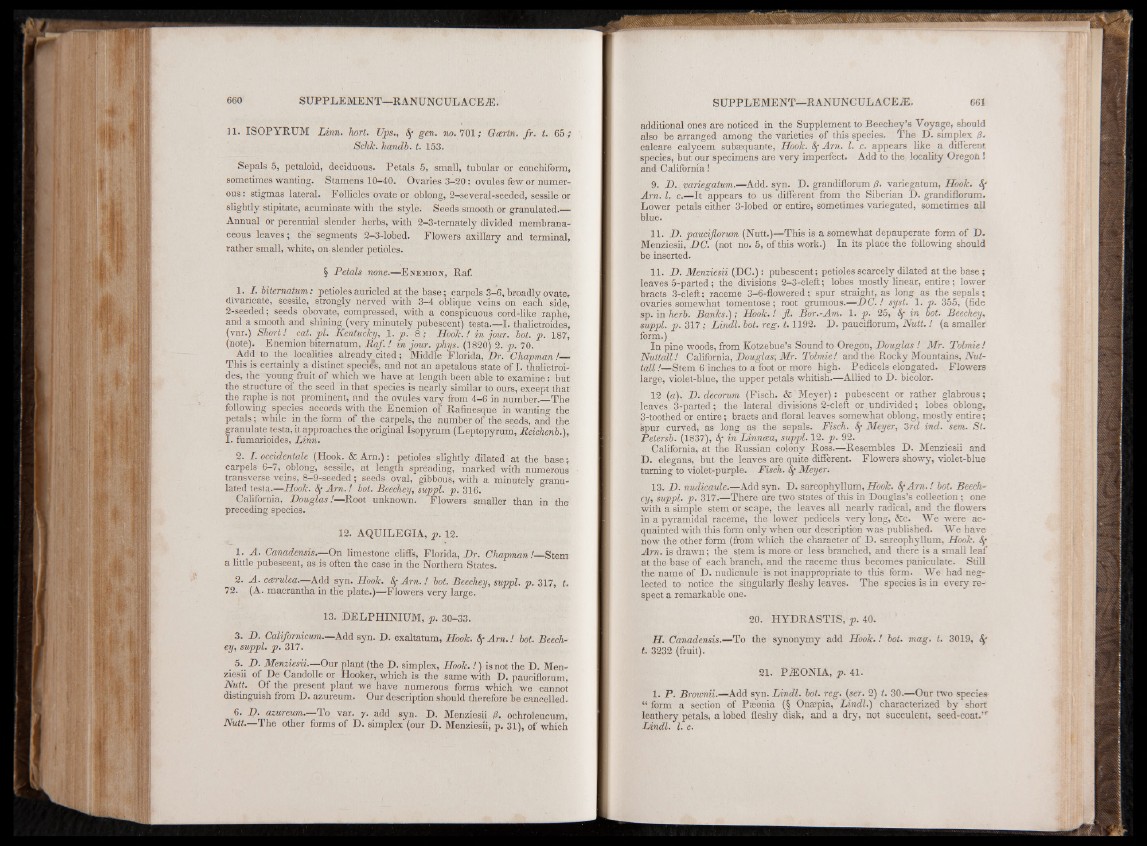
11. ISOPYRUM Linn. hort. Ups., Sf gen. no. 701; Gcertn. fr . t. 65;
Schk. handb. t. 153.
Sepals 5, petaloid, deciduous. Petals 5, small, tubular or conchiform,
sometimes wanting. Stamens 10-40. Ovaries 3-20: ovules few or numerous:
stigmas lateral. Follicles ovate or oblong, 2-several-seeded, sessile or
slightly stipitate, acuminate with the style. Seeds smooth or granulated.—
Annual or perennial slender herbs, with 2-3-ternately divided membranaceous
leaves; the segments 2-3-lobed. Flowers axillary and terminal,
rather small, white, on slender petioles.
§ Petals none.—E nemion, Raf.
1. I. biternatum: petioles auricled at the base; carpels 3-6, broadly ovate,
divaricate, sessile, strongly nerved with 3—4 oblique veins on each side,
2-seeded; seeds obovate, compressed, with a conspicuous cord-like raphe,
and a smooth and shining (very minutely pubescent) testa.—I. thalictroides,
(var.) Short.' cat. pi. Kentucky, .1. p. 8 ; Hook.! in jour. bot. p. 187,
(note). Enemion biternatum, Raf. ! in jour. phys. (1820) 2. p. 70.
Add to the localities already cited; Middle Florida, Dr. Chapman /—
This is certainly a distinct species, and not an apetalous state of I. thalictroides,
the- young fruit of which we have at length been able to examine: but
the structure of the seed in that species is nearly similar to ours, except that
the raphe is not prominent, and the ovules vary from 4-6 in number.—The
following species accords with the Enemion of Rafinesquë in wanting the
petals; while in the form of the carpels, the number of the seeds, and the
granulate testa, it approaches the original Isopyrum (Lep tony rum, Reichenb.),
I. fumarioides, Linn.
2. I. occidentale (Hook. & Arn.): petioles slightly dilated at the base;
carpels 6-7, oblong, sessile, at length spreading, marked with numerous
transverse veins, 8-9-seeded; seeds oval, gibbous, with a minutely granulated
testa.—Hook. Sf A m .! bot. Beechey, suppl. p. 316.
California, Douglas!—Root unknown. Flowers smaller than in the
preceding species.
12. AQUILEGIA, p . 12.
1. A. Canadensis.—-On limestone eliffs, Florida, Hr. Chapman!—Stem
a little pubescent, as. is often the case in the Northern States.
2. A . ccerulea.—Add syn. Hook. Sç A m . ! bot. Beechey, suppl. p . 317, t.
72. (A. macrantha in the plate.)—Flowers very large.
13. D E L PH IN IUM , p . 30-33.
3. D. Californicum.—Add syn. D. exaltatum, Hook. Sr A m . ! bot. Beechey,
suppl. p . 317.
5. D. Menziesii.—Our plant (the D. simplex, Hook. !) is not the D. Men-
ziesii of De Candolle or Hooker, which is the same with D. pauciflorum,
Nutt. Of the present plant we have numerous forms which we cannot
distinguish from D. azureum. Our description should therefore be cancelled.
6. D. azureum.—To var. y. add syn. D. Menziesii /?. ochroleucum,
Nutt.—The other forms of D. simplex (our D. Menziesii, p. 31), of which
additional ones are noticed in the Supplement to Beeehey’s Voyage, should
also be arranged among the varieties of this species. The D. simplex 0.
calcare calycem subsequante, Hook. Sf Am. 1. c. appears like a different
species, but our specimens are very imperfect. Add to the locality Oregon!
and California!
9. D. variegatum.—Add. syn. D. grandiflorum 0. variegatum, Hook. Sf
Am. I, c.—It appears to us different from the Siberian D. grandiflorum.
Lower petals either 3-lobed or entire, sometimes variegated, sometimes all
blue.
11. D. pauciflorum, (Nutt.)—This is a somewhat depauperate form of D.
Menziesii, DC. (not no. 5, of this work.) In its place the following should
be inserted.
11. D. Menziesii (DC.): pubescent; petioles scarcely dilated at the base;
leaves 5-parted; the divisions 2-3-cleft; lobes mostly linear, entire; lower
bracts 3-cleft; raceme 3-6-flowered; spur straight, as long as the sepals;
ovaries somewhat tomentose; root grumous.—DC.! syst. 1. p. 355, (fide
sp. in herb. Banks.); Hook.! fl. Bor.-Am. 1. p. 25, Sf in bot. Beechey,
suppl. p. 317; Lindl. bot. reg. 1.1192. D. pauciflorum, Nutt. ! (a smaller
form.) ' /
In pine woods, from Kotzebue’s Sound to Oregon, Douglas ! Mr. Tolrnie!
Nuttall! California, Douglas', Mr. Tolrnie!, and the Rocky Mountains, Nut-
tall !—Stem 6 inches to a foot or more high. Pedicels elongated. Flowers
large, violet-blue, the upper petals whitish.—Allied to D. bicolor.
12 (a). D. decorum (Fisch. & Meyer) : pubescent or rather glabrous;
leaves 3-parted ; the lateral divisions 2-cleft or. undivided; lobes oblong,
3-toothed or entire; bracts and floral leaves somewhat oblong, mostly entire;
spur curved, as long as the sepals. Fisch. Sf Meyer, 3rd ind. sem. St.
Pelersb. (1837), Sf in Linncea, suppl. 12. p. 92.
California, at the Russian colony Ross.—Resembles D. Menziesii and
D. elegans, but the leaves are quite different. Flowers showy, violet-blue
turning to violet-purple. Fisch. Sf Meyer.
13. D. nudicaule.—Add syn. D. sarcophyllum, Hook. SfArn.! bot. Beechey,
suppl. p. 317.—There are two states of this in Douglas’s collection ; one
with a simple stem or scape, the leaves all nearly radical, and the flowers
in a pyramidal raceme, the lower pedicels very long, &c. We were acquainted
with this form only when our description was published. We have
now the other form (from which the character of D. sarcophyllum, Hook. Sf
Arn. is drawn; the stem is more or less branched, and there is a small leaf
at the base of each branch, and the raceme thus becomes paniculate. Still
the name of D. nudicaule is not inappropriate to this form. We had neglected
to notice the singularly fleshy leaves. The species is in every respect
a remarkable one.
20. HYDRASTIS, p. 40.
H. Canadensis.—To the synonymy add Hook.! bot. mag. t. 3019, Sf
t. 3232 (fruit).
21. PÆONIA, p. 41.
1. P. Brownii.—Add syn. Lindl. bot. reg. (ser. 2) t. 30.—Our two species
“ form a section of Pæonia (§ Onæpia, Lindl.) characterized by short
leathery petals, a lobed fleshy disk, and a dry, not succulent, seed-coat.’'
Lindl. 1. c.